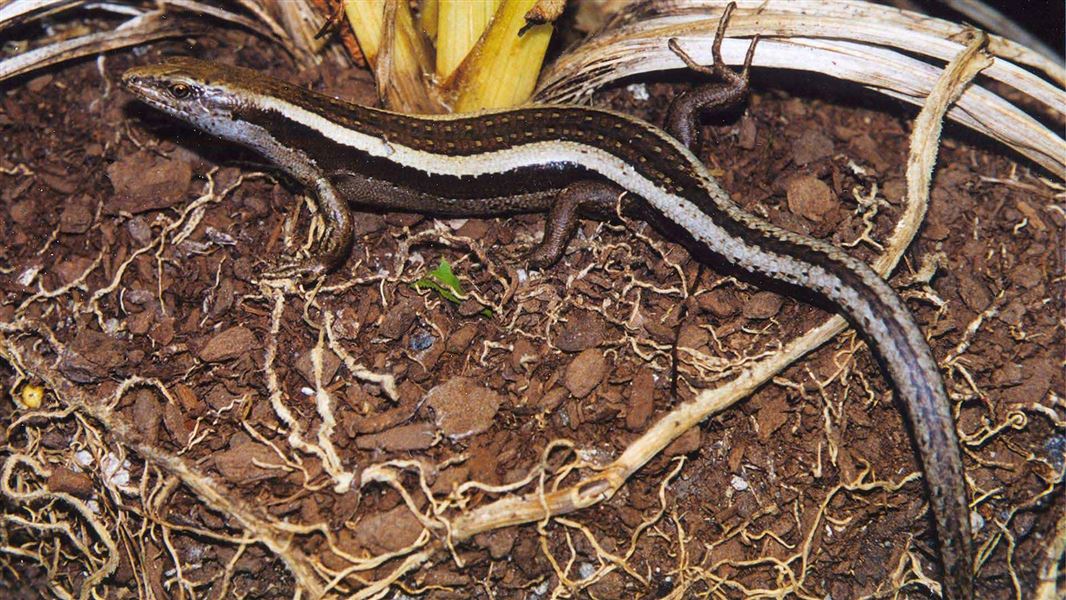Very little is known of its ecology and habits and all sightings and records of this skink can provide valuable clues to help DOC its continued survival.
Facts
The species is easily recognised by the pale stripes running down the length of its body, and makes for an eye-catching sight with its lightening quick movements.
The striped skink is listed as ‘Declining’ under DOC's Threat Classification system.
The sparse records for this species indicate that they are widespread through the central North Island up to Great and Little Barrier Islands although their secretive nature has meant that accurate population monitoring has not yet been able to take place.
Striped skinks give birth in summer and can have up to eight young in a litter. Although their growth rates and lifespan are unknown, an adult in captivity has lived for over 20 years.
Again, their diet in the wild is largely unknown, while in captivity they mainly eat insects, but will also eat soft fruit.
Habitat
Striped skinks are found in mature lowland forest and pastoral farmland. The striped skink is a good climber and may spend most of its time in the canopy of mature forest. It is known to live beneath flaking bark and crevasses in trunks, branches and epiphytes.
They also dwell in logs and litter on the forest floor. On farmland they tend to live in rotting logs or rank vegetation. Striped skinks have also been found in swampland.
Striped skinks have been shown to have high rates of evaporative water loss making them susceptible to dehydration. This may account for their apparent tendency to inhabit damp areas.
Population and range
Fewer than 150 striped skinks have ever been recorded from the wild and their actual population size is not known. They are presently known from several widely scattered inland locations throughout the central and northern North Island and on Great Barrier and Little Barrier Islands.
Threats
Predators
Cats, mustelids, and rats pose a threat to all lizards. However, the striped skink’s continued existence on the mainland may indicate that it can tolerate a low level of predation if sufficient habitat remains available.
Increasing mainland areas where predators are eradicated or controlled may improve these lizards’ chances of survival.
Habitat depletion
The loss of indigenous lowland forest from the North Island has led to the local extinction of many lizard populations.
Habitat loss may be the main threat to striped skinks, especially as a result of agricultural development. When forests are cleared, remaining rotting logs are eventually removed or disintegrate.
There is usually a limited amount of habitat available on farmland, so skink populations tend to be small and isolated. Therefore they are vulnerable to local extinction.
Our work
Research and recovery
Research and strategies for the conservation of striped skinks are covered in the North Island Oligosoma recovery plan. This is a multi species plan managed by the North Island skink recovery group.
The ecology, biology, and true range of the striped skink are poorly known, and the species has proved very difficult to find.
This is partly because survey and monitoring methods typically applied to skinks in New Zealand have not been very successful with striped skinks. This is possibly due to their arboreal nature.
Research into effective detection methods for this species remains the number one priority so that trends in populations can be monitored and managed for recovery.
Potential for recovery
Striped skinks have proved adaptable to modified environments in some cases and tenacious in the presence of predators although it is unknown how long they can maintain this.
Hauturu/Little Barrier Island may become a safe haven for striped skinks now that the rats have been eradicated leaving the island completely free of all mammalian predators. Mainland islands may also contribute to their improved survival by protecting forested lowland areas and reducing or eliminating predators.
You can help
Help us with your sightings
Your sightings and records of striped skinks are vital in helping us find out more about the ecology and habits of the striped skink.
They will help us put together a picture of preferred habitats, distribution and identify possible causes of decline.
If you have information about striped skinks please contact your local DOC office. If you find a striped skink take a photo if possible and note where it was found.
Remember:
- All native lizards including the striped skink are fully protected.
- Striped skinks should not be handled, interfered with in any way or taken from the wild.
